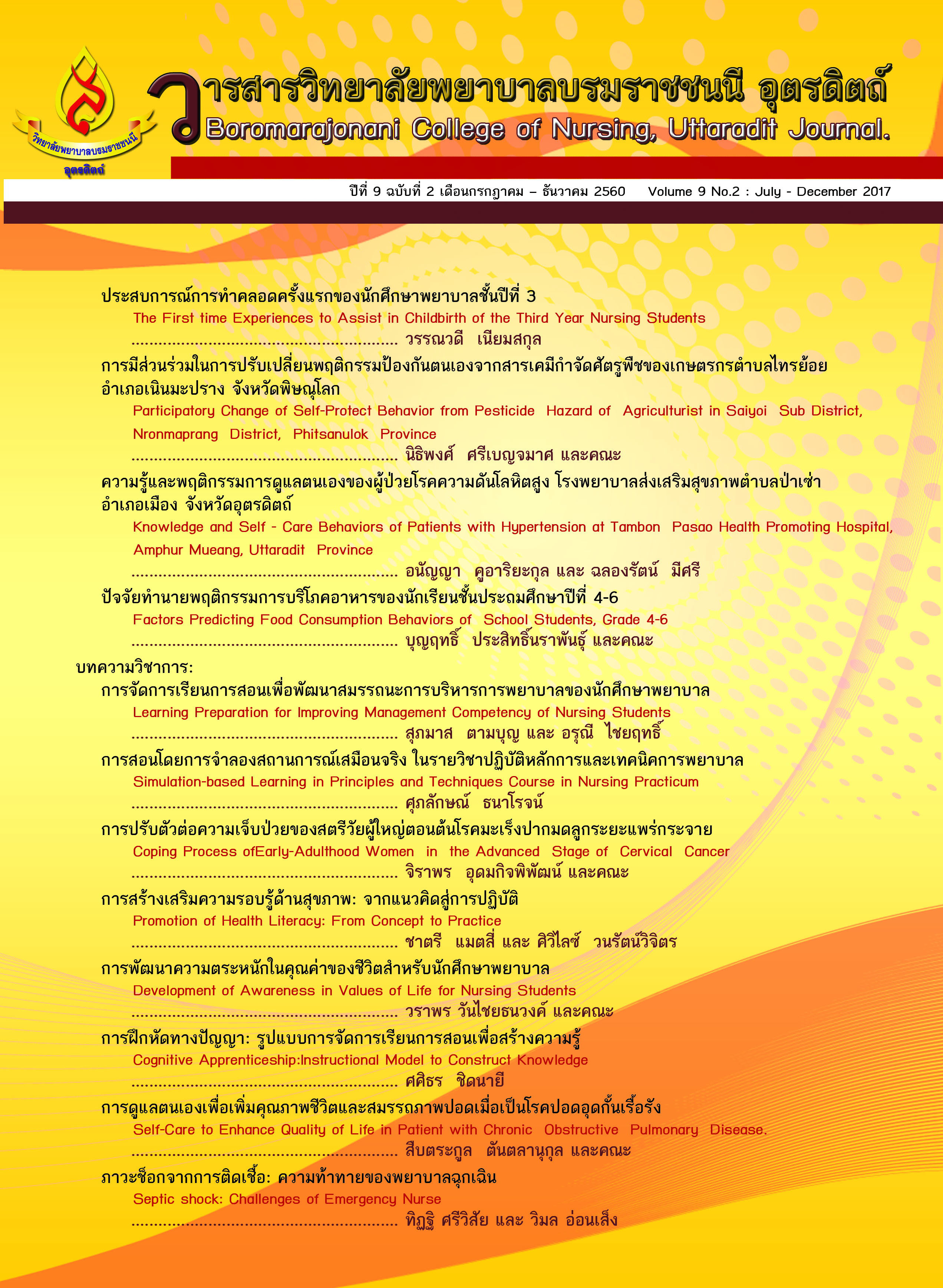การฝึกหัดทางปัญญา: รูปแบบการจัดการเรียนการสอนเพื่อสร้างความรู้
Main Article Content
บทคัดย่อ
Cognitive apprenticeship is an instructional model that makes thinking visible, tacit knowledge of an expert or teacher used to solve complicated problems. Learners can see intellectual and cognitive skills.Learners observe and practice in the real situation or authentic environments through modeling, coaching, scaffolding, articulation, reflection and exploration.This article presented PM-CARE Model based on cognitive apprenticeship. It can help students to construct their own knowledge, improve professional competencies, and develop critical thinking
Article Details
บทความหรือข้อคิดเห็นใดใดที่ปรากฏในวารสารวิจัยการพยาบาลและวิทยาศาสตร์สุขภาพ เป็นวรรณกรรมของผู้เขียน ซึ่งบรรณาธิการหรือสมาคมศิษย์เก่า ไม่จำเป็นต้องเห็นด้วย และบทความที่ได้รับการตีพิมพ์เผยแพร่ถือเป็นลิขสิทธิ์ของวารสารวิจัยการพยาบาลและวิทยาศาสตร์สุขภาพ
เอกสารอ้างอิง
2. Chidnayee, S. (2016) . The Development of an instructional model based on cognitive apprenticeships to enhance critical thinking in nursing process abilities for nursing students . (Dissertation) . Phitsanuloke: Naresuan University; 2016. (in Thai).
3. Collins, A., Brown,J.S., & Holum, A. (1991). Cognitive apprenticeship: Making thinking visible. American Educator, 15 (3), 6-11.
4. Collins, A.,Brown, J.S., & Newman, S.E. (1987) . Cognitive apprenticeship : Teaching the craft of reading, writing, and mathematics. (Technical report No 403). BBN Laboratories, Cambridge, MA. Center for the study of reading, University of Illinois. January 1987.
6. Darabi, A.A (2005). Application of cognitive apprenticeship model to a graduate course in performance systems analysis: A case study. Educational Technology Research and Development, 53(1), 49-61.
7. deJager, B. (2002). Teaching reading comprehension: the effects of direct instruction and cognitive apprenticeship on comprehension skills and metacognition. Doctoral dissertation, Ph. D., University of Groningen.
8. Dickey, M.D. (2008). Integrating cognitive apprenticeship methods in a web-based educational technology course for P12 teacher education. Computers & Education. 51(2), 506–518.
9. Ghefaili, A. (2003). Cognitive apprenticeship, technology, and the dontextualization of learning environments. Journal of Educational Computing, Design & Online learning, 4 (fall), 1-27.
10. Kataoka - Yahiro, M., & Saylor, C. (1994) . A critical thinking model for nursing judgment. Journal of Nursing Education, 33(8), 351 -356.
11. Kuo, F.R., Hwang,GJ., Chen, SC.,& Chen, SY. (2012). A cognitive apprenticeship approach to facilitating web-based collaborative problem solving. Educational Technology & Society. 15 (4), 319–331.
12. Maher, M.A, Gilmore, J.A, Feldon, DF & Davis, TE. (2013). Cognitive apprenticeship and the supervision of science and engineering research assistants. Journal of Research Practice.9(2), Retrieved from http://jrp.icaap.org/index.php/jrp/article/ view/354/311
13. Nikkle, P.(2007). Cognitive apprenticeship: Laying the groundwork for mentoring registered nurses in the intensive care unit. The Canadian Association of Critical Care Nurses, 18(4), 19-27.
14. Pacific Policy Research Center. (2010). 21st Century Skills for Students and Teachers. Honolulu: Kamehameha. Schools, Research & Evaluation Division.
15. Rittideche, P. (2010).The Development of a mathematics instructional model using the cognitive apprenticeship approach for enhancing mathematics learning outcomes and self-regulation ability of undergraduate students in social sciences and humanities. (Dissertation). Bangkok: Chulalongkorn University. (In Thai)
16. Schunk, D.H. (2008). Learning theories: An educational perspective ( 5th ed.). New Jersey: Pearson Education.
17. Sorrell J.M.,& Brown, H.N. (1991). Mentoring students in writing: gourmet express versus fast food service. Journal of Nursing Education. 30(6), 284-286.
18. Stalmeijer, R.E., Dolmans, D.H.J.M., Wolfhagen ,I.H.A.P., &Scherpbier, A.J.J.A.(2009). Cognitive apprenticeship in clinical practice: can it stimulate learning in the opinion of students?.Advances in Health Sciences Education, 14,535– 546.doi 10.1007/s10459-008-9136-0
19. Stewart, S., & Dempsey, L.F. (2005). A longitudina l study of baccalaureate nursing students’ critical thinking dispositions. Journal of Nursing Education, 44(2), 81-84.
20. Taylor, K.L., & Care, W.D. (1999). Nursing education as cognitive apprenticeship: a framework for clinical education. Nurse Educator, 24 (4), 31-36.
21. Thorne, S.E. (2006). Nursing education: Key issues for the 21st century. Nurse Education Today.26(6).614– 621.
22. Wu, P.H., Hwang, GJ., Su, LH., & Huang, YM. (2012). A context - aware mobile learning system for supporting cognitive apprenticeships in nursing skills training. Educational Technology & Society, 15 (1): 223–236.
23. Zurmehly, J., Lynd, M. & Leadingham, C. (2011). Skillful coaching: New directions In teaching health assessment. Journal Of College Teaching & Learning,1(4), 57-62


